Khoresh bademjan is a hearty and super delicious Persian eggplant stew. This flavorful recipe combines eggplants, meat, tomatoes and spices to create a truly satisfying dish. Try it with saffron rice and tahdig for a comforting Persian meal.
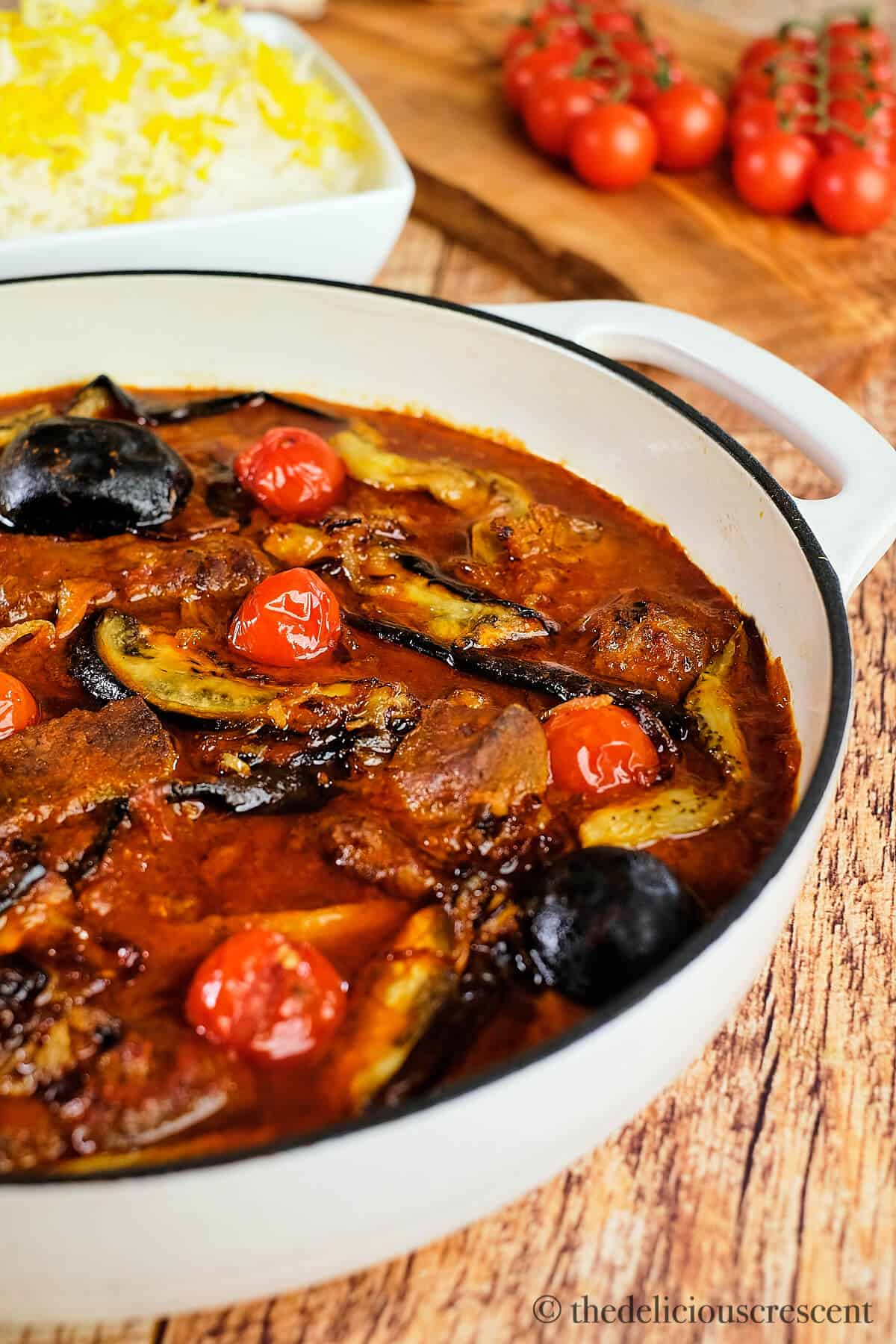
Persian Eggplant Stew
Khoresh bademjan, a classic Persian dish, is a stew made by slow-cooking eggplants, meat, tomatoes, spices, and various other ingredients. In Persian, "khoresh" means stew, while "bademjan" refers to eggplant, a popular vegetable in the Middle East.
Lamb is typically used in the recipe and is simmered in a flavorful tomato sauce that has a slight tartness to it. Traditionally, the stew is soured with unripe grapes, known as "ghooreh" in Persian, but dried limes or lemon and lime juice can also be used as substitutes.
Khoresh bademjan is popular at Persian gatherings, along with fesenjan and ghormeh sabzi. This dish can also be made vegan by omitting the meat, which is also a traditional stew in Iran. Another variation is to add yellow split peas to the stew, known as khoresh-e gheymeh bademjan.
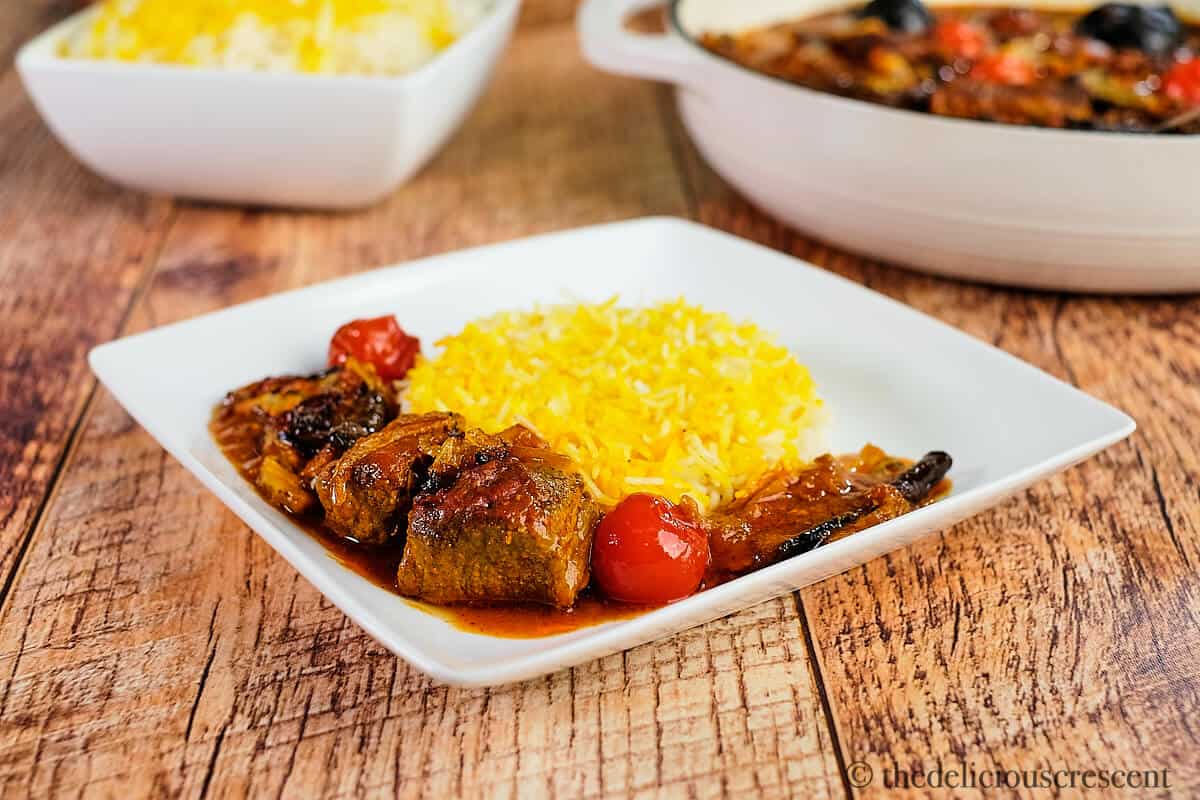
Recipe Ingredients
Here are some notes about ingredients.
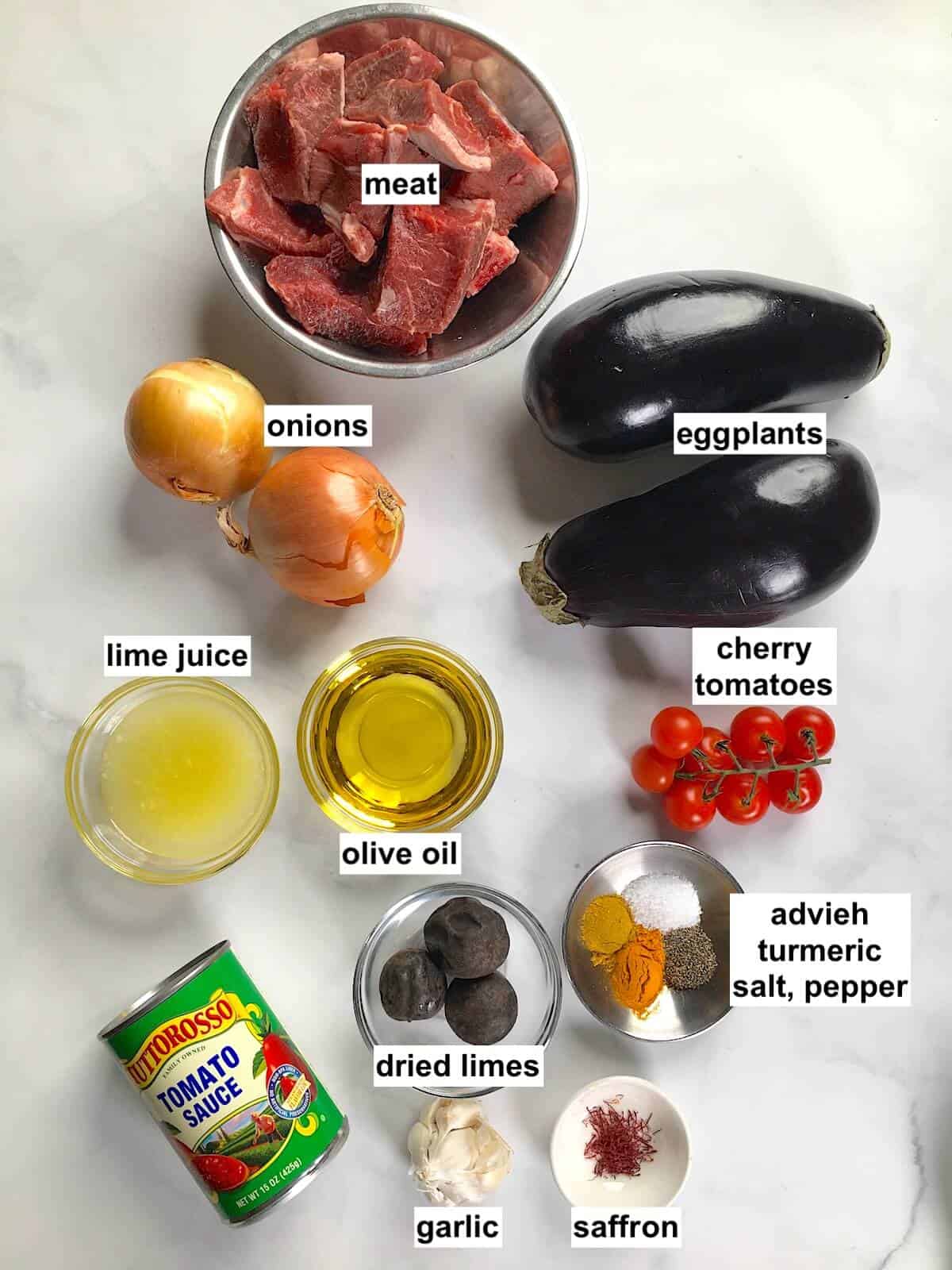
- Meat: Traditional choices are lamb, beef or veal. But you can use goat or chicken legs without skin. Lamb leg or shoulder with bone works best, as that adds a lot of flavor. Cooking time for chicken is about an hour and extra water is not necessary. Check vegetarian or vegan options under “variations”.
- Eggplant: Here I use globe/American variety as that is most easily available in the US. But Chinese or Japanese eggplants have fewer seeds and will work very well. Other options are Italian or Indian eggplant varieties. Select fresh, firm, medium size eggplant that is heavy for its size and with a shiny, smooth and vibrant purple skin. Also make sure that the stem is still green.
- Tomato Sauce: I use one 15 ounce can of tomato sauce. You can substitute with equal amount of canned tomatoes or 2½ cups fresh chopped tomatoes. To substitute with tomato paste, mix 8 ounces tomato paste and 8 ounces water until well combined.
- Onions: Large yellow onions work well. Peel, quarter and slice thinly.
- Cherry Tomatoes: These are optional but add a pop of color and beautiful presentation. Grape tomatoes will also be fine.
- Garlic: Use fresh garlic for best flavor.
- Souring Agents: Traditional options are fresh sour grapes, pickled sour grapes or abghooreh (sour grape juice) and these are available at Persian grocery stores. I use dried limes and lime or lemon juice as that is more readily available.
- Dried Limes: Rinse and pierce the limes using a fork. Lime juice or dried lime powder are other options.
- Cooking Oil: I use peanut oil, avocado oil or olive oil.
- Seasonings: Advieh (Persian spice blend), turmeric, ground black pepper and salt. For advieh, I use the one for khoresh. Substitute with a mild middle-eastern or eastern Mediterranean mixed spice blend.
- Saffron: This is optional. Use only the best quality product, preferably Persian saffron, which has an intense color and flavor.
How To Make Khoresh Bademjan
Brief overview below. *Full recipe at the end of blog post.
- Cook ⅓ sliced onions until golden brown and crisp. Sear the cherry tomatoes until edges are dark brown. Set aside.

- Saute remaining sliced onions until translucent. Add grated garlic and stir.
- Sear the meat on both sides until golden brown. Add seasonings and stir.

- Add water, tomato sauce, dried limes and saffron water (if using). Stir to combine and simmer until meat is 80 percent done.

- Slice eggplant and brush with olive oil on both sides. Bake until fork tender.
- Add the roasted eggplant and lime juice to the stew. Simmer until the eggplants are soft and tender.

- Taste and adjust the seasonings. Top with fried onions and seared cherry tomatoes and cook few minutes.
- Serve khoresh bademjan hot with Persian saffron rice and tahdig.
Top Tips
Add a pinch of salt when the onions are half cooked. This will help draw the moisture out of the onions and brown faster.
Slow cooking the stew yields the best results. It allows the meat and eggplants to achieve the perfect texture, while the sauce reaches the right consistency.
Use a wide cooking pot like a cast iron casserole dish. A very deep dish is not suitable for cooking this stew.
If using lime or lemon juice, add that one tablespoon at a time and adjust as per taste.
Don’t forget to add the fried onions and seared tomatoes towards the end of cooking time. These toppings take the stew up a notch.
Serving Suggestions
- With Persian saffron rice and tahdig (crispy crust). This is the most common and traditional way to enjoy this Persian eggplant stew.
- Add some flatbreads such as barbari.
- Salads such as shirazi salad, mast-o-musir (yogurt with shallots).
- The meatless version of this khoresh tastes very good with kotlet (Persian meat patties).
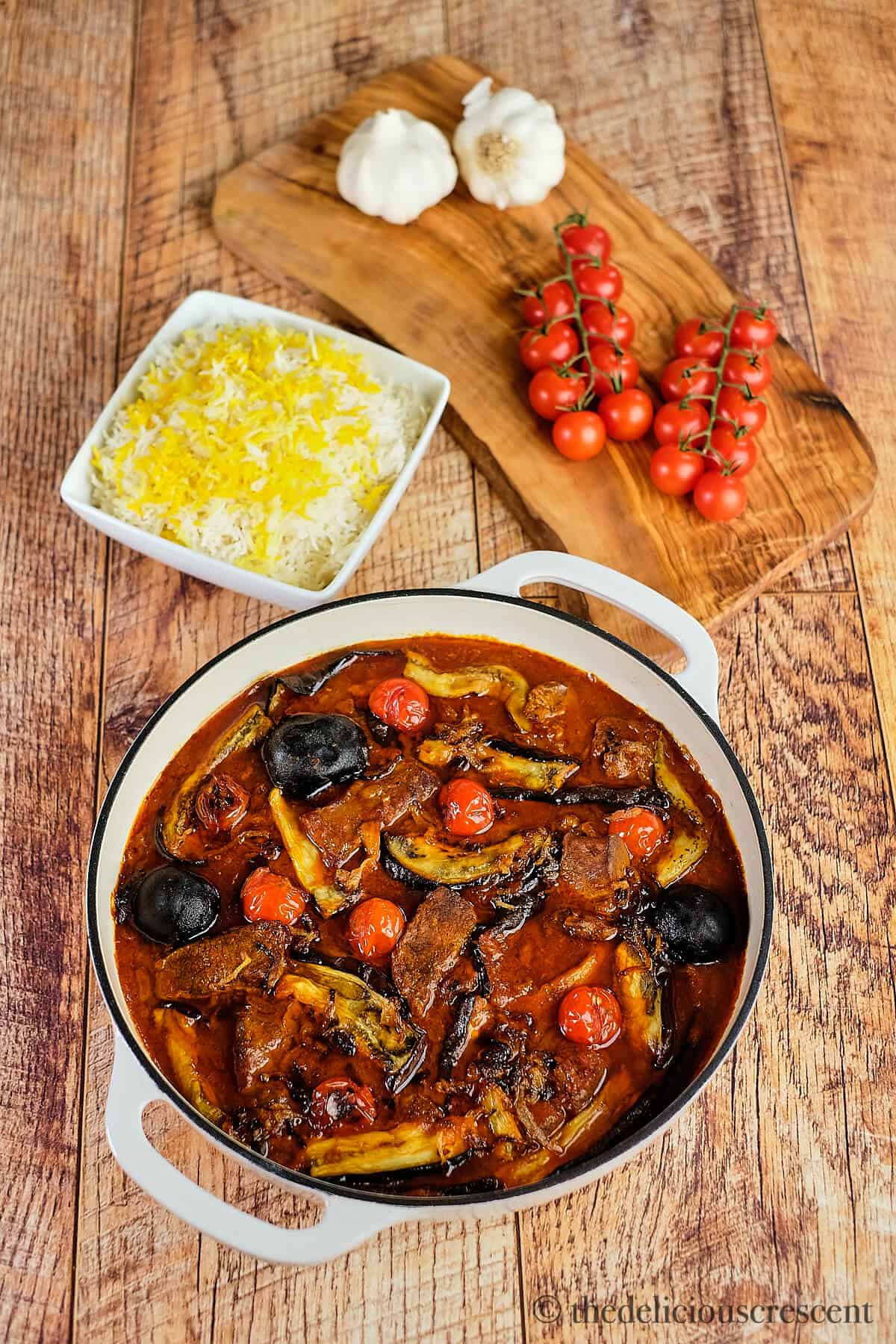
Variations
This stew is gluten free, high protein, dairy free, nut free, egg free, soy free and grain free.
How to make khoresh bademjan without meat: Just skip the meat and follow the recipe. This meatless vegan version is also prepared traditionally. You can add some yellow split peas if you prefer.
How to make khoresh bademjan with split peas (khoresh gheymeh bademjan): Cook ½ cup yellow split peas with 2 cups of water for 20 minutes. Drain and add to the stew in the last 10 minutes of cooking time.
Other Variations: You can replace the meat with other protein of your choice. This would not be traditional but you can customize to your taste. Some options are chickpeas, other beans, grilled tofu, paneer and halloumi.
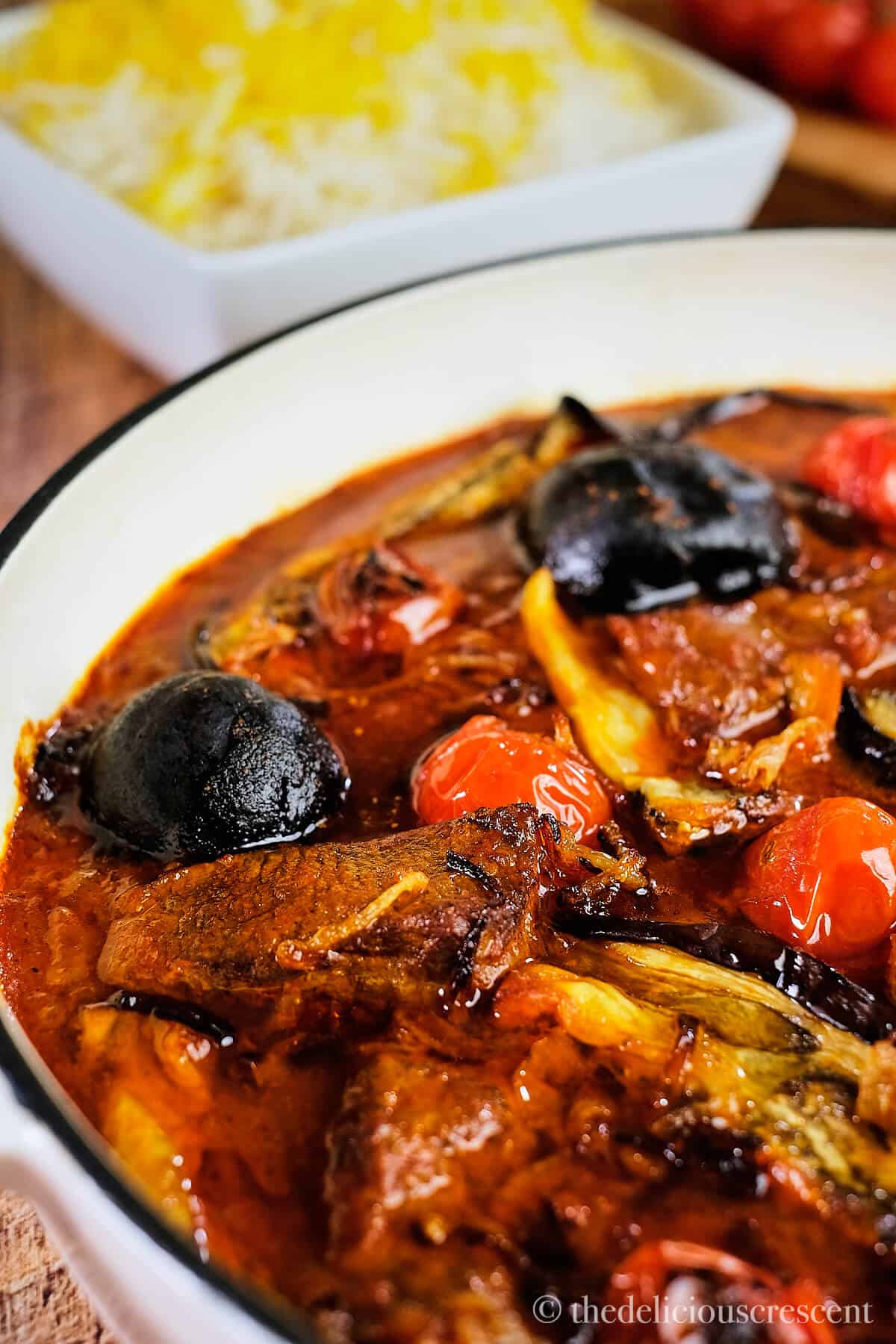
Recipe FAQs
Cook the eggplants until they are extremely tender using high-temperature methods such as baking, grilling, or frying and then add to the stew. As eggplants are primarily composed of water, they require ample room to evaporate properly when baking. Generously brush the eggplant with olive oil and bake at a high temperature until it is very tender.
The main thing is to cook them at high temperature. So you can do this by grilling, steaming, frying and roasting. Cooking eggplant over an open flame will also give it a smoky flavor.
Freeze the eggplants. To preserve the texture and taste, it is best to bake, roast, or fry them before freezing. Cut the eggplant into ½ to 1 inch thick slices. Brush generously with olive oil and bake on a parchment-lined baking sheet at 425°F for 25 minutes until fork tender. Allow to cool completely and pack in freezer safe bags, using parchment paper between layers. Freeze up to 6 months.
The best cuts for stew are shoulder or leg of lamb. Meat with some fat marbling is also good for slow cooked stews.
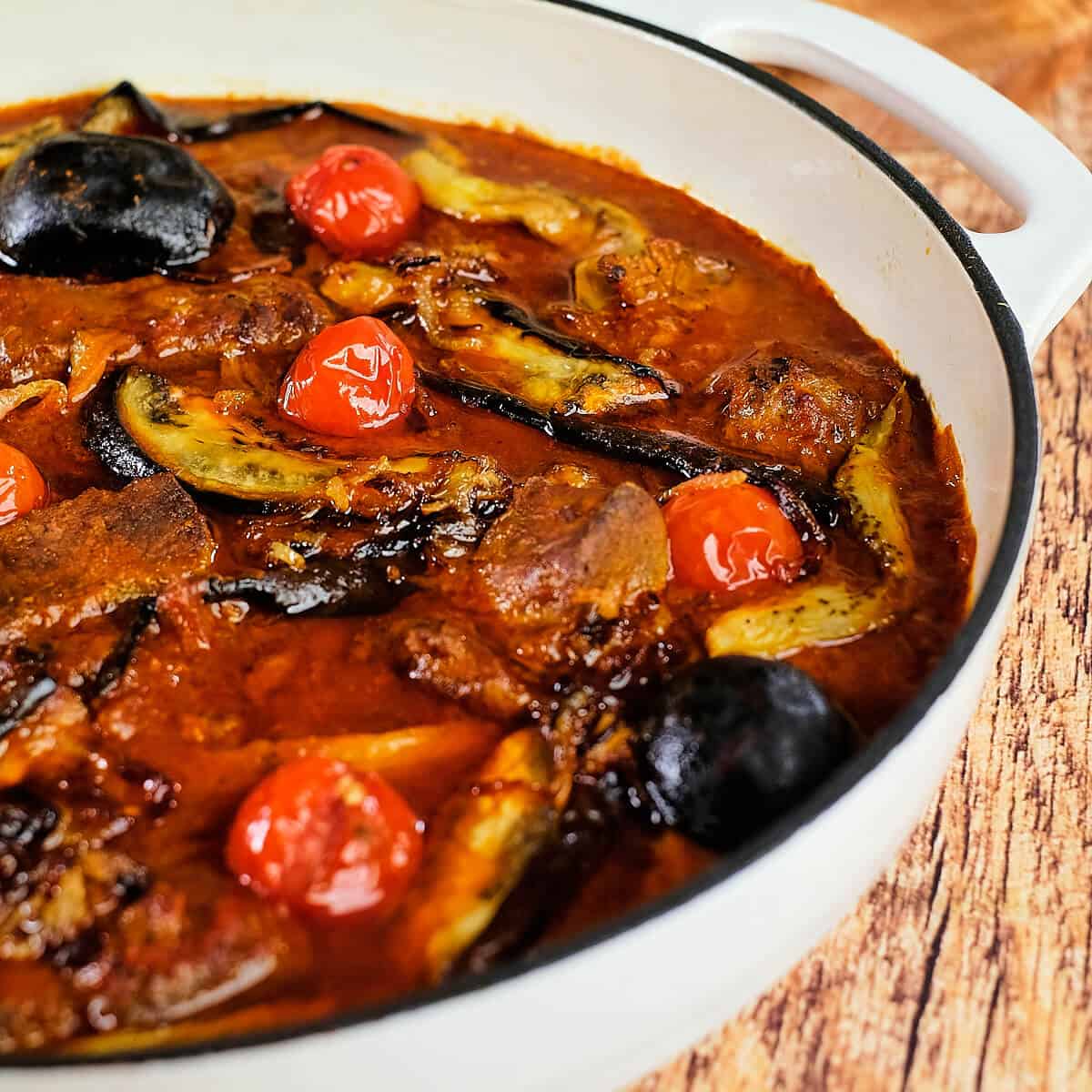
Nutrition Facts
This hearty stew combines protein rich lamb with nutritious eggplants. Lamb is a great source of high quality protein and vitamin B-12. It also provides niacin, zinc, selenium, phosphorus and Iron.
Consume red meats in moderate amounts, because a hight intake of red meats may increase the risk of certain chronic diseases. Try grass fed lamb as it is more lean and a better source of the beneficial nutrients - omega-3 fatty acids and conjugated linoleic acid.
Eggplants are high in fiber and low in calories and carbohydrates. They are also a good source of potassium, folic acid, manganese and phytochemicals.
The skin of eggplants is a rich source of anthocyanins, plant pigments with anti-inflammatory and antioxidant properties. Many people peel the skin of eggplants, but I retain it for the nutrients.
More Eggplant Recipes
- Eggplant Side Dish (Spicy Indian Eggplant)
- Mirza Ghasemi (Persian Eggplant Eggs)
- Eggplant Patties with Chickpeas
- Zaalouk (Moroccan Eggplant Dip)
★ DID YOU MAKE THIS RECIPE? PLEASE COMMENT AND GIVE IT A STAR RATING BELOW!
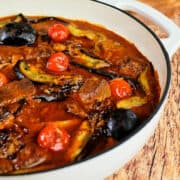
Khoresh Bademjan (Persian Eggplant Stew)
Ingredients
- ⅓ cup olive oil more as needed, divided
- 2 large onions peeled, quartered and sliced thinly
- 8 cherry tomatoes rinsed, pat dry, or grape tomatoes
- 4 cloves garlic grated
- 2 pounds lamb stew meat leg or shoulder with some bone, or 1½ lbs boneless meat
- 1 teaspoon advieh
- 1 teaspoon turmeric
- ½ teaspoon ground black pepper
- 1 teaspoon salt
- 2 cups water more as needed
- 1 15- ounce can tomato sauce or 2½ cups chopped tomatoes
- 3 dried limes rinsed and pierced, or 2 tablespoons lime juice, see note
- ½ teaspoon saffron ground and dissolved in 3 tablespoons hot water, optional
- 2 tablespoons lime juice more as per taste
- 2 eggplants large, globe variety, peeled and sliced
Equipment
- Cast Iron Casserole Dish
- Wooden Spoon
- Baking Sheet
Instructions
Stew
- In a wide dutch oven, heat 3 tablespoons olive oil at medium-high, until shimmering. Add ⅓ of the sliced onions and saute until light golden brown and crisp, about 10 to 15 minutes. Using a slotted spoon transfer the onions to a plate. Tip: Add a pinch of salt when the onions are half cooked.
- In the same dutch oven, add the cherry tomatoes and sear on all sides until edges are dark brown. Transfer the tomatoes to the same plate with fried onions.
- Add the remaining sliced onions to the dutch oven and saute until translucent, about 5 minutes. Then add grated garlic and stir until aromatic, about 1 minute.
- Push the sautéed onions to the edge of the pot or transfer to a plate. Drizzle more olive oil if needed. Arrange the lamb meat pieces in a single layer and raise the heat to high. Quickly sear the meat on both sides at high heat, until golden brown, about 3 minutes each side.Tip: It is important to brown the meat only on the surface and don't cook the inside.
- Add advieh, turmeric, black pepper and salt. Stir to combine with meat and sautéed onions. Then add some water, tomato sauce, dried limes, saffron water (if using) and stir well.
- Raise the heat and bring the mixture to a boil. Cover with a lid, lower the heat and simmer, until meat is 80 percent done, stirring in between, about 1¼ to 1½ hours (time will vary).
Prepare Eggplants
- While the stew is simmering, prepare the eggplant. Preheat oven to 425 ºF.
- If using large globe eggplants (American variety), cut the eggplant into halves and then cut ½ inch thick slices. Brush eggplant slices with 2 to 3 tablespoons olive oil on both sides.
- Arrange the slices on a parchment paper lined baking sheet and bake until fork tender, about 25 minutes (time may vary with oven). See notes for skillet fried eggplant.
Eggplant Khoresh
- Cut the roasted eggplant slices in the center if they are too large. Add the roasted eggplant and lime juice to the dutch oven and continue to simmer until the eggplants are soft and tender, about 30 minutes.
- The sauce will thicken and some oil will trickle to the surface. Meat should easily fall off the bone. Taste and adjust the seasonings. Top with fried onions and seared cherry tomatoes and cook another 10 minutes. Serve khoresh bademjan hot with Persian saffron rice and tahdig.
Notes
- Meat: Other choices are beef, veal, goat or chicken legs without skin. Cooking time for chicken is about an hour and extra water is not necessary. Skip the meat for a vegan version.
- Eggplant: I chose globe variety as that is more common in the US. But you can also try Chinese, Italian or Indian eggplant varieties.
- Tomato Sauce: Substitute with equal amount of canned tomatoes or 2½ cups fresh chopped tomatoes. To use tomato paste, mix 8 ounces tomato paste and 8 ounces water until well combined.
- Dried Limes (limu-omani): Pierce the limes in couple places before adding to the stew. You can remove the bitter seeds and grind it into lime powder. If you can find fresh sour grapes, pickled sour grapes or sour grape juice from Persian grocery stores, try that as it is traditional.
- Advieh: Use the one for khoresh. Substitute with a mild middle-eastern or eastern Mediterranean mixed spice blend.
- Stove Top Instructions: In a large cast iron skillet, heat 3 tablespoons oil over medium high and add eggplant slices. Fry the eggplant, flipping the slices, until edges are caramelized and eggplant is cooked through, about 10 to 15 minutes.
- Make Ahead: Roast eggplant slices up to 3 to 4 days ahead and refrigerate. You can also freeze roasted eggplant slices. Thaw and add to the stew.
- Storage and Leftovers: Refrigerate the khoresh for 4 to 5 days. Freeze the stew for up to 2 months. Reheat in microwave or on stove top, adding water as needed.
- For more information on ingredients, variations, recipe FAQs and serving suggestions, scroll up the page to the blog post.


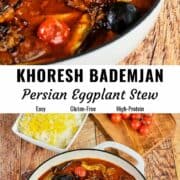
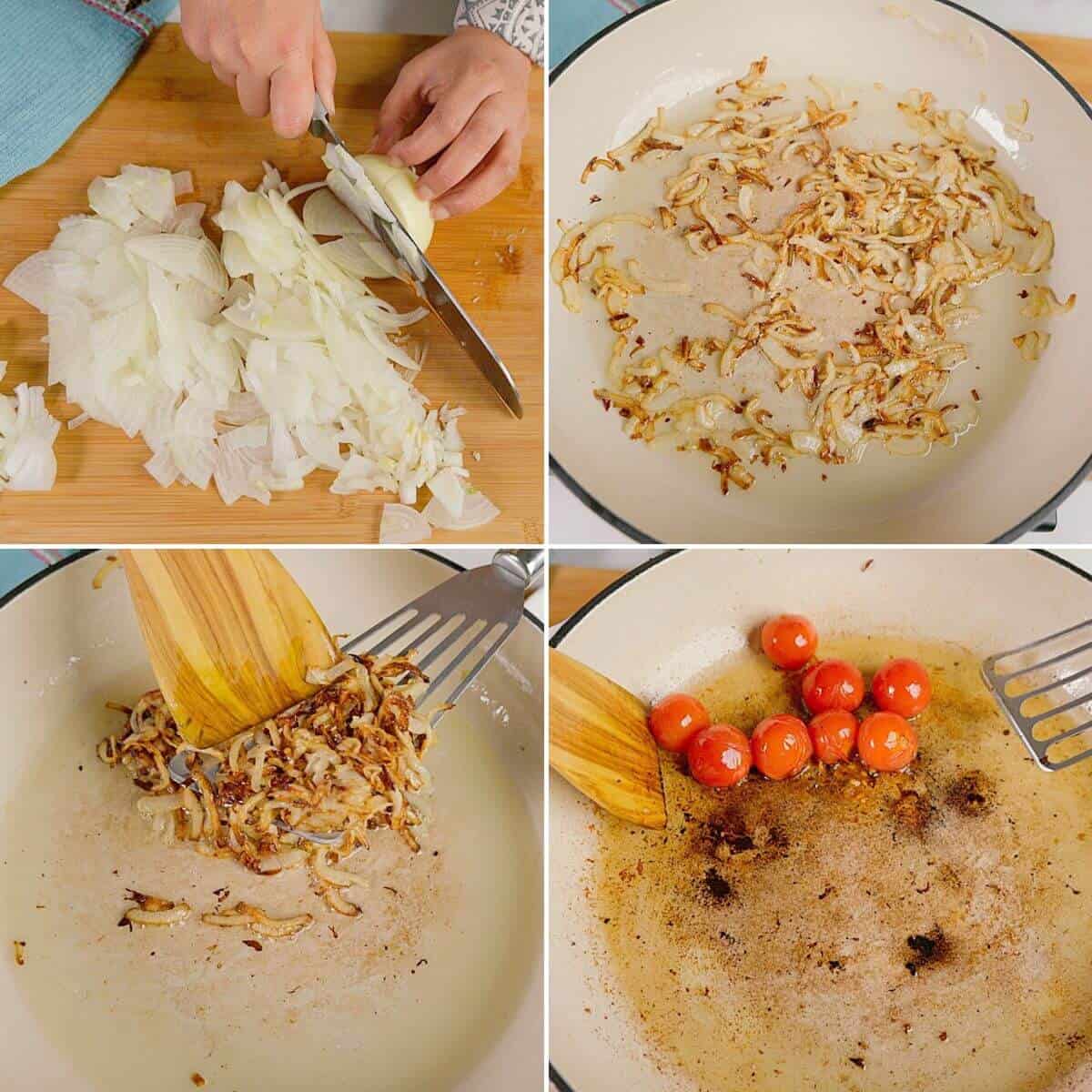

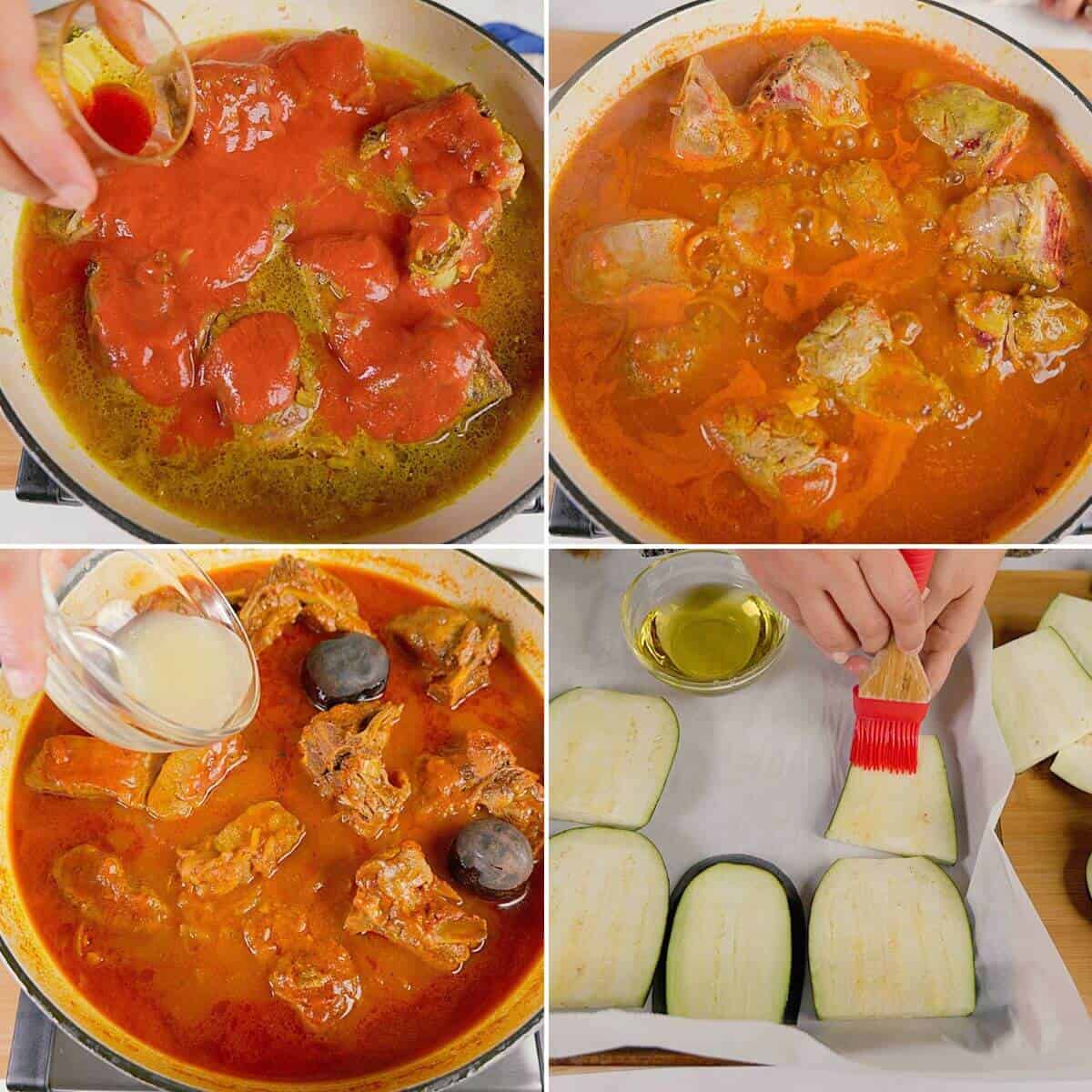
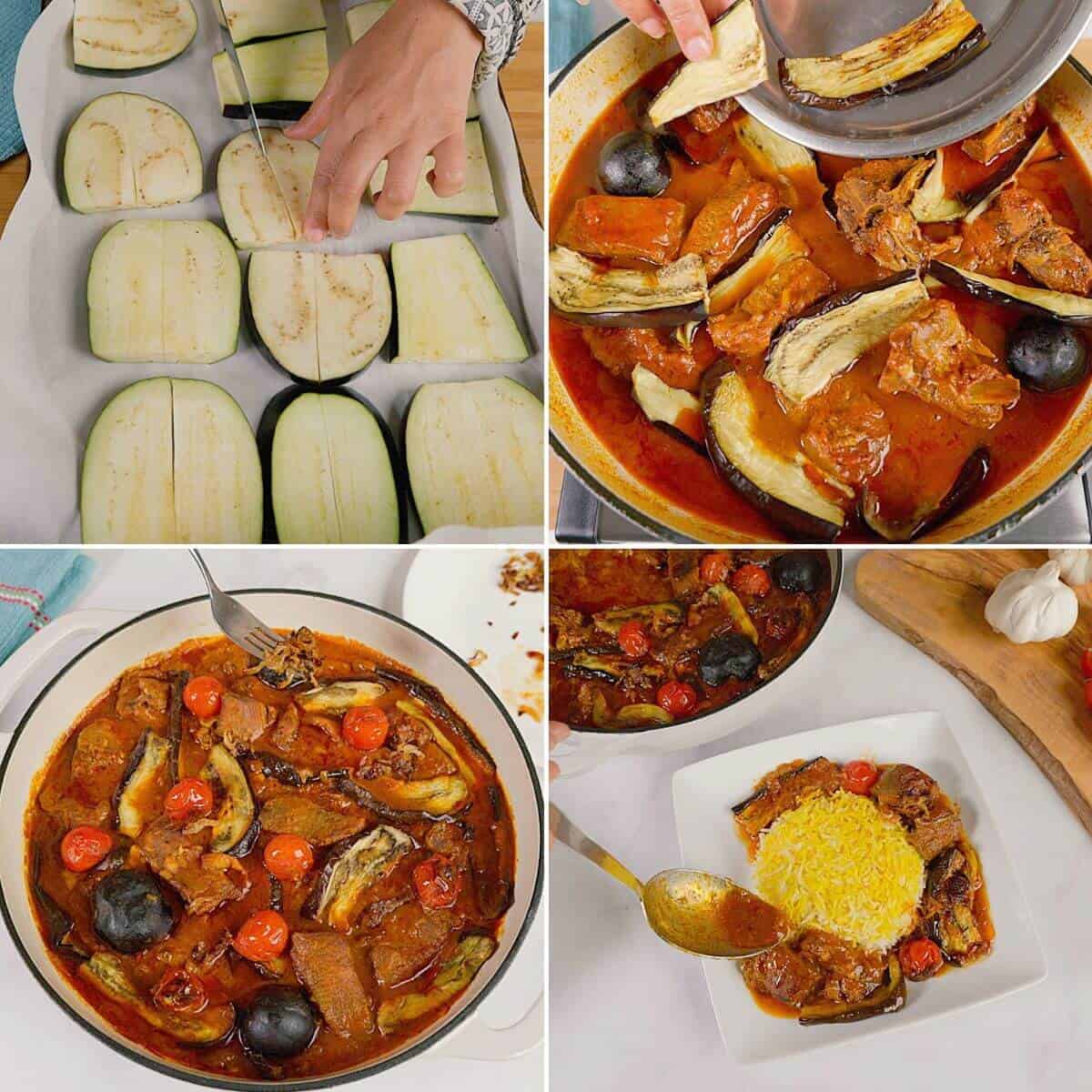
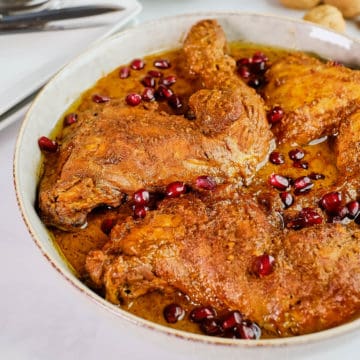
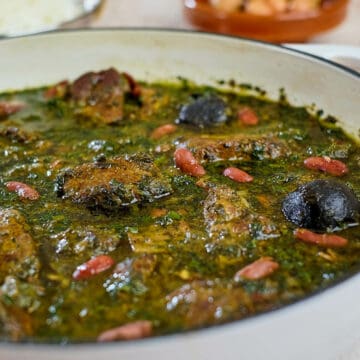


Margaret Girgrah
What spices are in advieh can I make the mix at home I cook a lot of Yemeni Indian and Thai foods , so I use a lot of different spices which I make at home
Roxana Begum
There is a recipe for advieh on the blog here. You can search for it.
Erin
Your recipes are amazing! I made this for dinner tonight with baghali polo. Your recipe for braised lamb shanks made me fall in love with Persian food! ❤️
Roxana Begum
Thanks :) so glad you enjoyed it!
Carol
This recipe is absolutely delicious. Initially it looked complicated but after reading it over found the recipe very clear. A lovely change of pace to use for company or a Sunday dinner. I also appreciated the nutritional information. Thank you for the recipe.